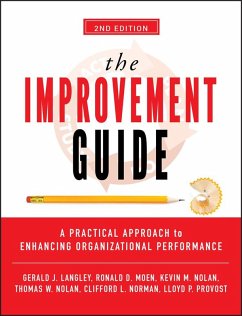The Improvement Guide (eBook, ePUB)
A Practical Approach to Enhancing Organizational Performance


Alle Infos zum eBook verschenken

The Improvement Guide (eBook, ePUB)
A Practical Approach to Enhancing Organizational Performance
- Format: ePub
- Merkliste
- Auf die Merkliste
- Bewerten Bewerten
- Teilen
- Produkt teilen
- Produkterinnerung
- Produkterinnerung

Hier können Sie sich einloggen

Bitte loggen Sie sich zunächst in Ihr Kundenkonto ein oder registrieren Sie sich bei bücher.de, um das eBook-Abo tolino select nutzen zu können.
This new edition of this bestselling guide offers an integrated approach to process improvement that delivers quick and substantial results in quality and productivity in diverse settings. The authors explore their Model for Improvement that worked with international improvement efforts at multinational companies as well as in different industries such as healthcare and public agencies. This edition includes new information that shows how to accelerate improvement by spreading changes across multiple sites. The book presents a practical tool kit of ideas, examples, and applications.
- Geräte: eReader
- mit Kopierschutz
- eBook Hilfe
- Größe: 7.6MB
![The Deep Change Field Guide (eBook, ePUB) The Deep Change Field Guide (eBook, ePUB)]() Robert E. QuinnThe Deep Change Field Guide (eBook, ePUB)20,99 €
Robert E. QuinnThe Deep Change Field Guide (eBook, ePUB)20,99 €![The Complete Guide to Mergers and Acquisitions (eBook, ePUB) The Complete Guide to Mergers and Acquisitions (eBook, ePUB)]() Timothy J. GalpinThe Complete Guide to Mergers and Acquisitions (eBook, ePUB)52,99 €
Timothy J. GalpinThe Complete Guide to Mergers and Acquisitions (eBook, ePUB)52,99 €![The Blue Line Imperative (eBook, ePUB) The Blue Line Imperative (eBook, ePUB)]() Kevin KaiserThe Blue Line Imperative (eBook, ePUB)27,99 €
Kevin KaiserThe Blue Line Imperative (eBook, ePUB)27,99 €![Throwing Sheep in the Boardroom (eBook, ePUB) Throwing Sheep in the Boardroom (eBook, ePUB)]() Matthew FraserThrowing Sheep in the Boardroom (eBook, ePUB)14,99 €
Matthew FraserThrowing Sheep in the Boardroom (eBook, ePUB)14,99 €![The Five Temptations of a CEO (eBook, ePUB) The Five Temptations of a CEO (eBook, ePUB)]() Patrick M. LencioniThe Five Temptations of a CEO (eBook, ePUB)11,99 €
Patrick M. LencioniThe Five Temptations of a CEO (eBook, ePUB)11,99 €![Organization Development (eBook, ePUB) Organization Development (eBook, ePUB)]() Organization Development (eBook, ePUB)44,99 €
Organization Development (eBook, ePUB)44,99 €![The Four Obsessions of an Extraordinary Executive (eBook, ePUB) The Four Obsessions of an Extraordinary Executive (eBook, ePUB)]() Patrick M. LencioniThe Four Obsessions of an Extraordinary Executive (eBook, ePUB)18,99 €
Patrick M. LencioniThe Four Obsessions of an Extraordinary Executive (eBook, ePUB)18,99 €-
-
-
Dieser Download kann aus rechtlichen Gründen nur mit Rechnungsadresse in A, B, BG, CY, CZ, D, DK, EW, E, FIN, F, GR, HR, H, IRL, I, LT, L, LR, M, NL, PL, P, R, S, SLO, SK ausgeliefert werden.
- Produktdetails
- Verlag: John Wiley & Sons
- Seitenzahl: 512
- Erscheinungstermin: 9. Juni 2009
- Englisch
- ISBN-13: 9780470549032
- Artikelnr.: 37297006
- Verlag: John Wiley & Sons
- Seitenzahl: 512
- Erscheinungstermin: 9. Juni 2009
- Englisch
- ISBN-13: 9780470549032
- Artikelnr.: 37297006
- Herstellerkennzeichnung Die Herstellerinformationen sind derzeit nicht verfügbar.
Foreword xi
Preface xv
Acknowledgments xviii
The Authors xix
Introduction: The Improvement Guide, Second Edition 01
PART ONE: INTRODUCTION TO IMPROVEMENT 13
Chapter One: Changes That Result in Improvement 15
Principles of Improvement 15
The Model for Improvement 23
Key Points from Chapter One 25
Chapter Two: Skills to Support Improvement 27
Supporting Change with Data 28
Developing a Change 35
Testing a Change 41
Implementing a Change 43
Spreading Improvements 44
The Human Side of Change 45
Key Points from Chapter Two 46
Chapter Three: Improvement Case Studies 49
Case Study 1: Improving the Morning Meeting 49
Case Study 2: Improving Service in a Dental Office 54
Case Study 3: Improving Methods for Teaching Biology 60
Case Study 4: Contamination in Shipping Drums 63
Case Study 5: Reducing Energy Use in School 66
Key Points from Chapter Three 71
PART TWO: METHODS FOR IMPROVEMENT 73
Chapter Four: The Science of Improvement 75
Profound Knowledge 76
Milestones in the Development of Profound Knowledge 85
Key Points from Chapter Four 88
Chapter Five: Using the Model for Improvement 89
What Are We Trying to Accomplish? 89
How Will We Know That a Change is an Improvement? 93
What Changes Can We Make That Will Result in Improvement? 96
The Plan-Do-Study-Act Cycle 97
Using the Cycle to Build Knowledge 100
Key Points from Chapter Five 106
Chapter Six: Developing a Change 109
Some Typical Problems in Developing Changes 110
Reactive Versus Fundamental Change 111
Theory for Change 116
Methods for Developing Fundamental Change 120
Key Points from Chapter Six 136
Chapter Seven: Testing a Change 139
Applying the Science of Improvement to Testing 140
Principles for Testing a Change 144
Designs for Testing a Change 153
Strategies for Testing 168
Key Points from Chapter Seven 170
Chapter Eight: Implementing a Change 173
Testing a Change 174
Implementing a Change 174
Implementation as a Series of Cycles 175
Implementing Changes to Achieve and Maintain Improvement 179
The Social Aspects of Implementing a Change 186
Key Points from Chapter Eight 193
Chapter Nine: Spreading Improvements 195
A Framework for Spread 196
Phase for Organizational Readiness for Spread 197
Phase for Developing an Initial Spread Plan 205
Phase for Executing and Refining the Spread Plan 210
Key Points from Chapter Nine 216
Chapter Ten: Integrating Methods for the Improvement of Value 217
Eliminating Quality Problems 218
Reducing Costs While Maintaining or Improving Quality 224
Expanding the Expectations of Customers to Increase Demand 230
Developing an Environment Conducive to the Improvement of Value 235
Key Points from Chapter Ten 236
Chapter Eleven: Improving Large or Complex Systems 237
Project Setup and Management 239
Understanding the System and Developing High-Impact Changes 243
Testing and Learning Systems 250
Key Points from Chapter Eleven 262
Chapter Twelve: Case Studies of Improvement Efforts 263
Case Study 1: Reducing the Occurrence of No-Fault-Found Components 264
Case Study 2: Improving the Drill Process 269
Case Study 3: Reducing Infection and Mortality Rates in a Pediatric
Intensive Care Unit 276
Case Study 4: Improving Safety at a Manufacturing Plant 285
Case Study 5: Improving the Credentialing Process at CareOregon 291
Case Study 6: Improving Sales at a Specialty Chemical Company 292
Key Points from Chapter Twelve 305
PART THREE: IMPROVING VALUE AS A BUSINESS STRATEGY 307
Chapter Thirteen: Making the Improvement of Value a Business Strategy 309
Building the System of Improvement 312
Key Points from Chapter Thirteen 328
Chapter Fourteen: Developing Improvement Capability 331
Developing Improvement Capability in the Workforce 333
Organization to Support the Focus on Improvement 340
Development of Other Capabilities 343
Key Points from Chapter Fourteen 346
Sample Agendas for Getting Started, Sponsors, and Improvement Advisors 348
Development of Internal Improvement Advisors: Topical Agenda 352
APPENDIXES 355
Appendix A: A Resource Guide to Change Concepts 357
How to Use Change Concepts 358
The Change Concepts 363
Appendix B: Tools and Methods to Support Improvement 409
Methods and Tools for Viewing Systems and Processes 410
Methods and Tools for Gathering Information 417
Methods and Tools for Organizing Information 423
Methods and Tools for Understanding Variation 433
Methods and Tools for Understanding Relationships 440
Methods and Tools for Project Management 442
Standard Forms for Improvement Projects 445
Appendix C: The Model for Improvement and Other Roadmaps 453
Fundamental Questions for Improvement 454
Alternative Roadmaps for Improvement Projects 456
Summary 464
Notes 465
Index 479
Foreword xi
Preface xv
Acknowledgments xviii
The Authors xix
Introduction: The Improvement Guide, Second Edition 01
PART ONE: INTRODUCTION TO IMPROVEMENT 13
Chapter One: Changes That Result in Improvement 15
Principles of Improvement 15
The Model for Improvement 23
Key Points from Chapter One 25
Chapter Two: Skills to Support Improvement 27
Supporting Change with Data 28
Developing a Change 35
Testing a Change 41
Implementing a Change 43
Spreading Improvements 44
The Human Side of Change 45
Key Points from Chapter Two 46
Chapter Three: Improvement Case Studies 49
Case Study 1: Improving the Morning Meeting 49
Case Study 2: Improving Service in a Dental Office 54
Case Study 3: Improving Methods for Teaching Biology 60
Case Study 4: Contamination in Shipping Drums 63
Case Study 5: Reducing Energy Use in School 66
Key Points from Chapter Three 71
PART TWO: METHODS FOR IMPROVEMENT 73
Chapter Four: The Science of Improvement 75
Profound Knowledge 76
Milestones in the Development of Profound Knowledge 85
Key Points from Chapter Four 88
Chapter Five: Using the Model for Improvement 89
What Are We Trying to Accomplish? 89
How Will We Know That a Change is an Improvement? 93
What Changes Can We Make That Will Result in Improvement? 96
The Plan-Do-Study-Act Cycle 97
Using the Cycle to Build Knowledge 100
Key Points from Chapter Five 106
Chapter Six: Developing a Change 109
Some Typical Problems in Developing Changes 110
Reactive Versus Fundamental Change 111
Theory for Change 116
Methods for Developing Fundamental Change 120
Key Points from Chapter Six 136
Chapter Seven: Testing a Change 139
Applying the Science of Improvement to Testing 140
Principles for Testing a Change 144
Designs for Testing a Change 153
Strategies for Testing 168
Key Points from Chapter Seven 170
Chapter Eight: Implementing a Change 173
Testing a Change 174
Implementing a Change 174
Implementation as a Series of Cycles 175
Implementing Changes to Achieve and Maintain Improvement 179
The Social Aspects of Implementing a Change 186
Key Points from Chapter Eight 193
Chapter Nine: Spreading Improvements 195
A Framework for Spread 196
Phase for Organizational Readiness for Spread 197
Phase for Developing an Initial Spread Plan 205
Phase for Executing and Refining the Spread Plan 210
Key Points from Chapter Nine 216
Chapter Ten: Integrating Methods for the Improvement of Value 217
Eliminating Quality Problems 218
Reducing Costs While Maintaining or Improving Quality 224
Expanding the Expectations of Customers to Increase Demand 230
Developing an Environment Conducive to the Improvement of Value 235
Key Points from Chapter Ten 236
Chapter Eleven: Improving Large or Complex Systems 237
Project Setup and Management 239
Understanding the System and Developing High-Impact Changes 243
Testing and Learning Systems 250
Key Points from Chapter Eleven 262
Chapter Twelve: Case Studies of Improvement Efforts 263
Case Study 1: Reducing the Occurrence of No-Fault-Found Components 264
Case Study 2: Improving the Drill Process 269
Case Study 3: Reducing Infection and Mortality Rates in a Pediatric
Intensive Care Unit 276
Case Study 4: Improving Safety at a Manufacturing Plant 285
Case Study 5: Improving the Credentialing Process at CareOregon 291
Case Study 6: Improving Sales at a Specialty Chemical Company 292
Key Points from Chapter Twelve 305
PART THREE: IMPROVING VALUE AS A BUSINESS STRATEGY 307
Chapter Thirteen: Making the Improvement of Value a Business Strategy 309
Building the System of Improvement 312
Key Points from Chapter Thirteen 328
Chapter Fourteen: Developing Improvement Capability 331
Developing Improvement Capability in the Workforce 333
Organization to Support the Focus on Improvement 340
Development of Other Capabilities 343
Key Points from Chapter Fourteen 346
Sample Agendas for Getting Started, Sponsors, and Improvement Advisors 348
Development of Internal Improvement Advisors: Topical Agenda 352
APPENDIXES 355
Appendix A: A Resource Guide to Change Concepts 357
How to Use Change Concepts 358
The Change Concepts 363
Appendix B: Tools and Methods to Support Improvement 409
Methods and Tools for Viewing Systems and Processes 410
Methods and Tools for Gathering Information 417
Methods and Tools for Organizing Information 423
Methods and Tools for Understanding Variation 433
Methods and Tools for Understanding Relationships 440
Methods and Tools for Project Management 442
Standard Forms for Improvement Projects 445
Appendix C: The Model for Improvement and Other Roadmaps 453
Fundamental Questions for Improvement 454
Alternative Roadmaps for Improvement Projects 456
Summary 464
Notes 465
Index 479







